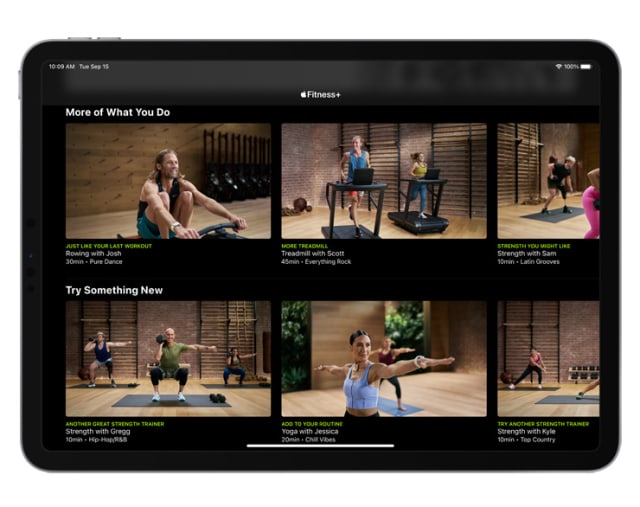I’m at the stage of my pandemic fitness routine where if I finish a workout without having yelled in frustration, I have to wonder if the session was too easy. Whether it’s because I’ve grown bored or I’m getting stronger, I’ve struggled to find exercise videos that suit my needs. Admittedly, I’m also very picky — I get annoyed by coaches who are too peppy, talk too much about themselves or don’t give clear instructions. I’m also specifically looking for dance cardio classes with great music or hour-long advanced yoga sessions. So that limits my options.
When Apple introduced Fitness+ earlier this year, I was intrigued. For $10 a month, the company offers a variety of exercise videos and promises that new ones will be added frequently. This concept isn’t new, of course — companies like Peloton, Daily Burn, Alo Yoga and ClassPass have been serving their members on-demand videos since before the pandemic. There’s also a ton of free workout content on YouTube and Instagram. But Apple’s service is tightly integrated with its smartwatch line, which display metrics like duration, heart rate and progress on your wrist. Apple Music also lets you see what songs will be played ahead of time and add them to your playlist. Plus, Fitness+ includes yoga and dance classes, which suits me well.
Before trying out Fitness+ I mostly relied on Chromecasting ClassPass’ videos and my local yoga studio’s subscription service. Neither of these offer any kind of smartwatch integration, but they provide the types of workouts and training I’m looking for. Producing professional-looking content is easy enough — plenty of players like Peloton and Alo Yoga excel at that — but it’s the Apple Watch integration that sets Fitness+ apart.

Speaking of the sort, let’s get one thing out of the way: You need an Apple Watch to use Fitness+. The service is designed to be used with it. Though you can launch workouts without wearing the watch, you have to have one attached to your account to access Fitness+. All Apple TVs will have the app installed, and when you click Fitness+, the streaming box will scan for Apple watches in the vicinity before it will launch the program. If it detects none are nearby, you won’t be able to launch the app. After you select your workout, hit “Let’s Go” on your iPhone (or iPad or Apple TV), and the watch will vibrate and show a play button to begin the session when you’re ready.
Then, as you’re exercising, metrics like your heart rate, elapsed time and your progress toward your activity rings will appear onscreen. When a coach calls out a timed set — 30 seconds of burpees, say — a countdown clock will also appear. I love this, since not all trainers make it easy to keep track of how long you’ve been jumping (and some are just bad at counting). There’s also something Apple calls the “burn bar,” which measures your performance against other users and shows where you place. The burn bar is motivating, but it only appears on some videos like HIIT workouts. It was absent from the yoga and dance classes I tried. Peloton’s workout app offers similar onscreen info, but it’s not as sophisticated.
As you might expect, the best thing about Fitness+ is the way it’s integrated across Apple’s devices. In my old routine, I would strap on the Apple Watch to log my activity, hit play on my remote, then press start on my wrist too. As I’m jumping about, I’d have to look at the watch to see how I was doing — Apple’s service makes it easy to see. Often, I forgot to launch or finish sessions, and would clock inaccurate durations. With Fitness+, though, the Watch starts and ends your workouts with the video, so you don’t have to think about it.

That’s something you won’t find on services from Fitbit and Samsung, which also offer workout content alongside their wearables. Similar to Fitness +, Fitbit Premium costs $10 a month and includes a Coach program with simple exercise videos and guides on nutrition, sleep and meditation. Samsung Health is free, and you can play its workouts on Samsung TVs too, but most of the content is from third parties. Perhaps Apple’s stiffest competition is Peloton, but it’s more expensive at $13 a month. Plus, to get similar onscreen metrics, you’d have to shell out north of $2,000 for one of the company’s treadmills or bikes — at which point the monthly fee skyrockets to $40. (The cheaper subscription is for people who don’t own the company’s exercise machines.)
Apple easily outshines the competition on Watch integration, but that alone doesn’t make a fitness service. The quality of the workouts themselves is a huge factor to consider. Fitness+ offers a decent range of activities, including yoga, dance, core exercises, strength training, high-intensity intervals, treadmill runs, rowing and indoor cycling, for those who have access to the appropriate machines. There’s also an intro section for beginners to get them started on basics like proper form or how to correctly set up your rowing machine. The rest of the videos run between five and 45 minutes, and while you can search by trainer, music, duration and activity, you can’t filter by difficulty level.
I was surprised when I found myself picking a video based on the type of music, even in non-dance workouts. I chose a core session with no preference for a trainer, and based my decision entirely on the fact that it would play upbeat anthems. When you find a workout you like, you can save it on your iPhone, but this option wasn’t available on Apple TV.

Frankly, all the workouts on Fitness+ seem to cater to newbies. Apple says on its website that the service “is created for everyone from beginners to experts,” and that all the videos offer modifications for all levels. While I appreciate that in theory, in practice none of the yoga videos were challenging enough. I tried two 45-minute videos and a few shorter options, and found myself missing the tougher poses and holds from my regular classes.
I also found the dance classes fairly easy, though they did get my heart rate up. The workouts I found most challenging were HIIT and core. Yoga is often perceived as being low-intensity and almost relaxing, but that’s not really the case. That said, the selection on Fitness+ only perpetuates this myth.
Aside from that, I don’t have many complaints about the workouts themselves. Every trainer I encountered was very likable. The coaches also appear in each other’s videos backing up the lead, posing as modification examples. These cameos are fun — I liked seeing my favorite dance coach LaShawn in a yoga workout, for example. I also thought it was interesting to see an expert in one categories appear in videos where they might be more of a novice.

Another thing the coaches did was use American Sign Language (ASL) to welcome users who might be deaf or hard of hearing. At the end of many of the workouts I tried, trainers signed “thank you,” for example. It’s a nice touch, though I think more could still be done. In some workouts, like yoga, you may lose sight of the screen in poses like downward dog or child’s pose. These situations make it difficult for the hearing-impaired to know when to move on or get up again. Something as simple as a haptic cue on the Watch could make Fitness+ much more accessible.
Inclusion is important, and with Fitness+ Apple does its best to welcome those new to working out to the world of home exercise. But it could do better at including intermediate and advanced users too. Over time, novice users will improve and may quickly find Fitness+ no longer challenging enough. This is a simple enough issue to address, at least — Apple can easily add more videos of greater difficulty over time. The good news is that with its excellent tech, Fitness+ has laid the groundwork for a satisfying service that can grow with its users.
https://ift.tt/351gLDh
Technology
Bagikan Berita Ini














0 Response to "Two weeks with Apple Fitness+ - Engadget"
Post a Comment